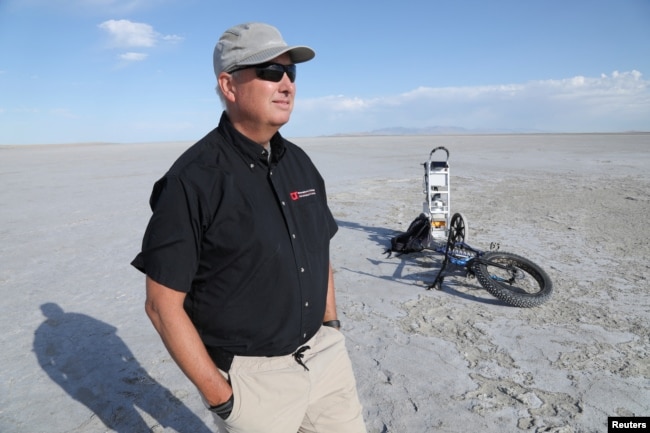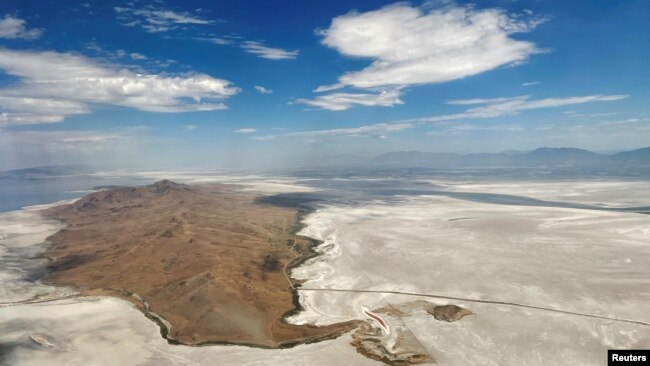分かっていたのに、何もしてこなかったことへのつけがこの地球を襲っています。
朝、太陽が上り、夕方には空を赤く染め沈んでいく。人々の営みがあり、動植物の息遣いがある。それら全てがリンクして生態系を保っているこの大地。
負のスパイラルに。。。。
VOAで英語を学びましょう!!
- グレート・ソルト・レイクが縮小する中、何かをしなければならないという圧力が高まる(和訳)
- As Great Salt Lake Shrinks, Pressure to Do Something Grows
グレート・ソルト・レイクが縮小する中、何かをしなければならないという圧力が高まる(和訳)
As Great Salt Lake Shrinks, Pressure to Do Something Grows
July 18,2022
ユタ州のグレート・ソルト・レイクの水面が今年7、観測史上最も低いレベルにまで低下しました。
研究者や政治家は、動物やその近くに住む人々への深刻な脅威を心配しています。
近くのソルトレイクシティはすでに砂嵐に見舞われています。専門家は、空気中に土を吹き飛ばすこの嵐が、さらにひどくなることを恐れています。
科学者のケビン・ペリー氏は、長年にわたってこの湖を研究してきました。「グレート・ソルトレイクを守り、ダスト・レイクシティにならないようにするためには、湖は貴重であり、湖に水を入れる必要があるという...選択をすることです。」と彼は言います。
長年、湖に注ぐはずだった水は、飲料水や工業、農業に使われてきました。さらに、干ばつが続いているため、十分な雨が降らない時期が長く続き、湖の水位が下がっています。
7月3日、米国地質調査所(USGS)は、湖の水面が1847年の記録開始以来、最も低い水準まで低下したと発表しました。水位は秋から初冬にかけてさらに低下するとみられます。
湖の水量は現在、1987年の最高水位時の4分の1程度となっています。
湖の平均表面積は半分近くまで減少しています。つまり、約2,000平方キロメートルの湖底が露出したことになります。
水中にあった土が乾燥し、カルシウムや硫黄、ヒ素を含む砂ぼこりが発生しています。ヒ素は、がんや胎児の発育障害につながる元素です。また、露出した湖底には、銅や銀の採掘で残った化学物質もあります。
ペリー氏はロイター通信の取材に対し、「数十年以上といった長期間にわたってその粉塵を吸い続けると、さまざまな種類のがん...cardiovascular disease,心臓血管疾患、diabetes 糖尿病などの増加につながる可能性があります。」と語っています。
危険にさらされているのは人間だけではありません。海中の岩礁のような構造物には、鳥の重要な餌であるブラインシュリンプの餌となる微生物が生息しています。しかし、岩礁のような構造物は空気に触れると乾燥し、灰色に変色してしまいます。
毎年330種以上、推定1,000万羽の鳥が湖を旅したり、湖に住んだりしていると、マックス・マルムクイスト氏は話します。彼は、環境保護団体、National Audubon Society,所属しています。
エビも収穫され、数百万ドルの価値があります。当局の推定では、湖からの経済活動は毎年最大で20億ドルの価値があるとのことです。
ユタ州知事のスペンサー・コックス氏は、最後の立法期、立法会、に水政策を扱う11の新しい法律に署名しました。長期的には、農業、工業、都市で水の使用量を減らす必要があります。
ユタ州議会議員のティム・ホークス氏は、政治的な圧力がかかっているといいます。言います
「過去最低を記録すると、グレート・ソルトレイクから得られるすべての価値が危険にさらされる可能性があります。」と、彼は言っています。
As Great Salt Lake Shrinks, Pressure to Do Something Grows
The surface of Utah's Great Salt Lake dropped to its lowest recorded level this July.
Researchers and politicians are worried about serious threats to animals and people who live near it.
The nearby city of Salt Lake City is already facing dust storms. Experts fear these storms, which blow dirt into the air, could get worse.
Scientist Kevin Perry has studied the lake for years. He said, "To save the Great Salt Lake, so that we don't become Dust Lake City, is to make a…choice that the lake is valuable and that the lake needs to have water put into it."
For years, water that would have gone to the lake has been used for drinking water, industry and agriculture. In addition, an ongoing drought – a long period of time with not enough rain - has reduced the lake’s water level.
On July 3, U.S. Geological Survey (USGS) said that the surface of the lake fell to the lowest level since records began in 1847. Water levels are expected to decrease further until the autumn or early winter.
The lake now contains about one-fourth of the water it contained when it was at its highest level in 1987.
The lake has lost nearly half its average surface area. This means about 2,000 square kilometers of lakebed have been exposed.
Dried out earth that used to be underwater has created dust clouds that contain calcium, sulfur and arsenic. Arsenic is an element linked to cancer and developmental problems in unborn babies. Exposed lakebed also has chemicals left over from copper and silver mining.
Perry told the Reuters news agency, "If you breathe that dust over an extended period of time, like decades or longer, then it can lead to increases in different types of cancer...cardiovascular disease, diabetes and such."
People are not the only ones at risk. Underwater reef-like structures are home to a micro-organism that is food for brine shrimp, which are an important food for birds. But the reef-like structures dry out and turn gray when exposed to air.
An estimated 10 million birds of more than 330 species travel through or live at the lake each year, said Max Malmquist. He is with the National Audubon Society, an environmental group.
The shrimp are also harvested and are valued at millions of dollars. Officials estimate that economic activity from the lake is worth up to $2 billion each year.
Utah Governor Spencer Cox signed 11 new laws dealing with water policy in the last lawmaking season, or legislative session. Long-term answers will require agriculture, industry, and cities to use less water.
Utah State Representative Tim Hawkes said there is political pressure to do something.
"As we hit these new record lows, we start to run the risk that all of those values that we derive from the Great Salt Lake could be at risk," he said.
Words in This Story
lakebed – n. the floor or bottom of a lake
expose – v. to leave (something) without covering or protection
reef – n. a long line of rocks or coral or a high area of sand near the surface of the water in the ocean
brine shrimp – n. a small kind of shrimp that live in salt lakes
species – n. biology : a group of animals or plants that are similar and can produce young animals or plants : a group of related animals or plants that is smaller than a genus
derive – v. to take or get (something) from (something else); to have something as a source : to come from something

